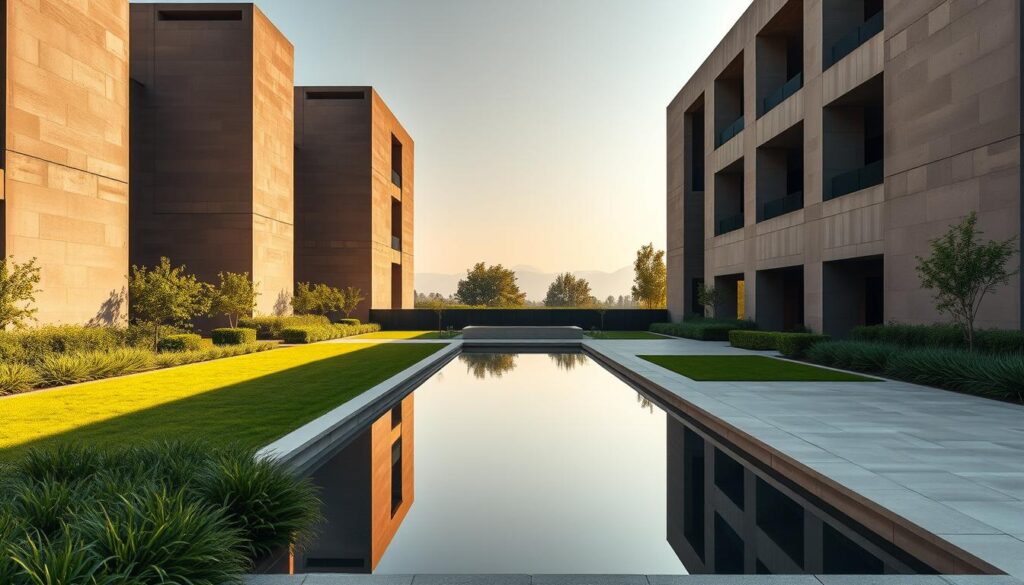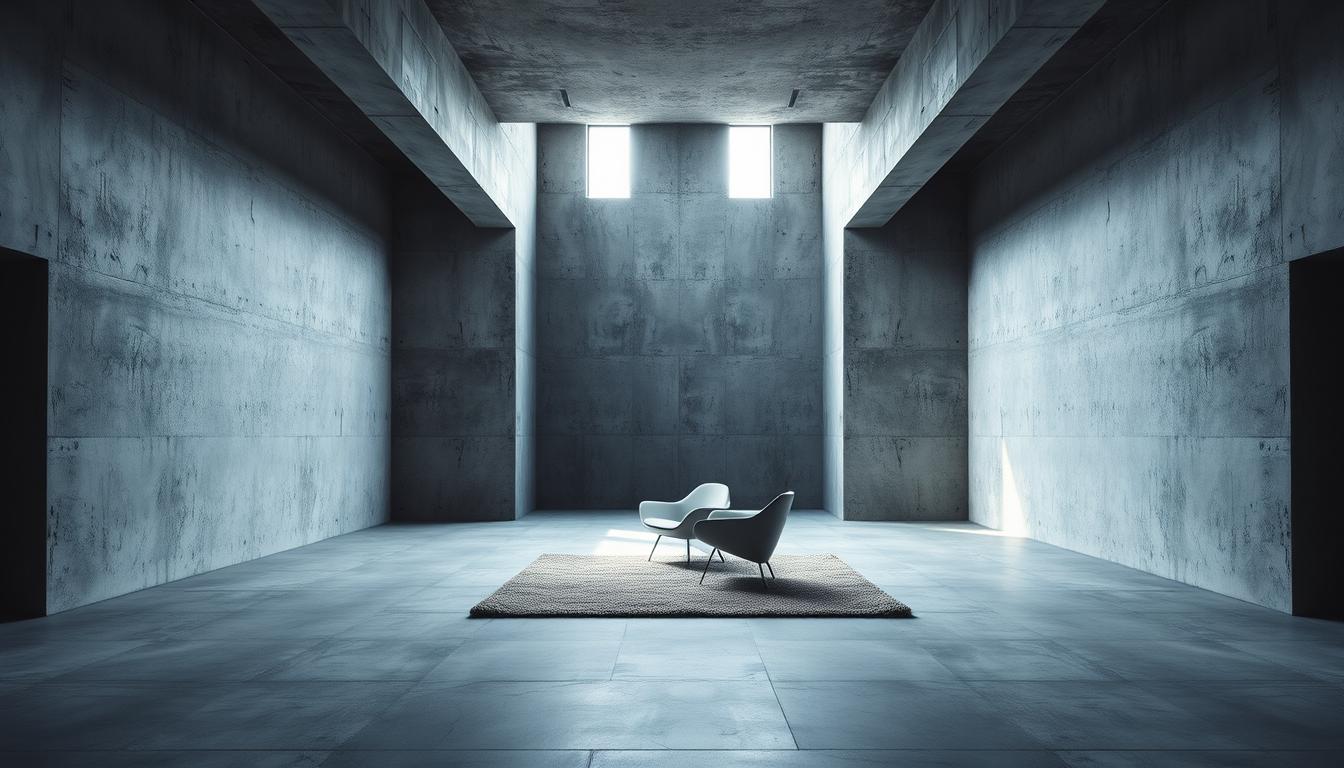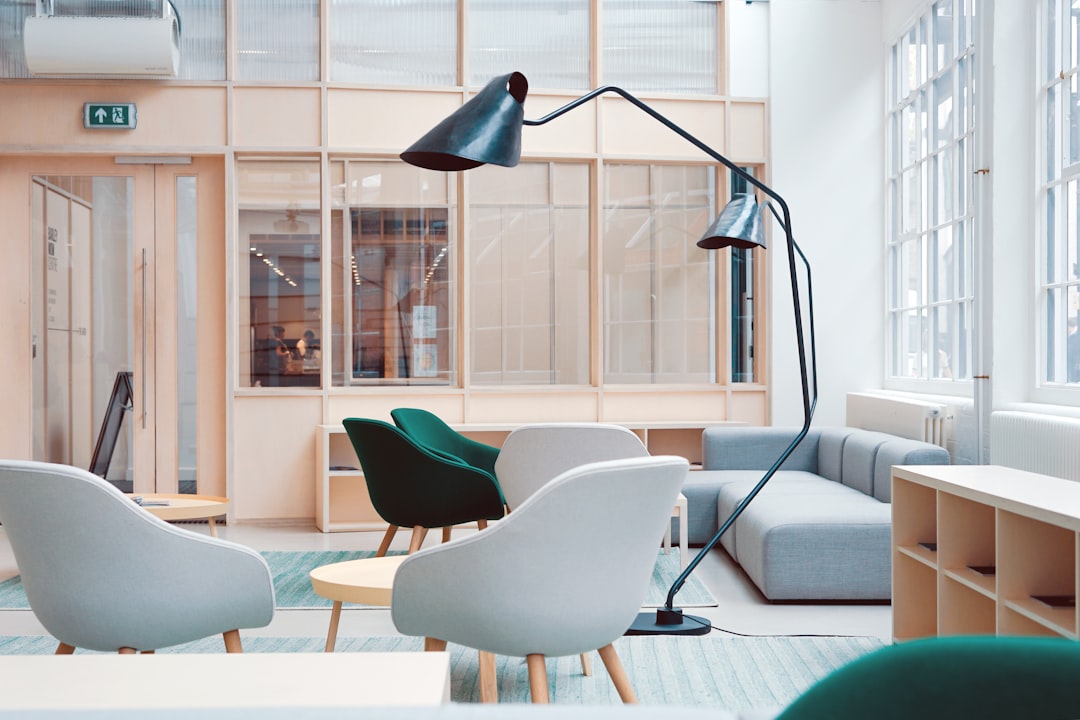Did you know brutalist architecture is back in style? It’s not just for buildings anymore. Now, it’s also making its way into homes and offices.
Get ready to explore brutalist interior design. It’s where function meets bold, raw style. Our guide will show you how to create stunning, brutalist-inspired spaces. They’ll be both eco-friendly and eye-catching.
Key Takeaways
- Understanding the core principles of brutalist style
- How to incorporate brutalist elements into your space
- The benefits of adopting a brutalist aesthetic
- Tips for balancing form and function
- Creating a sustainable and stylish brutalist interior
What is Brutalist Interior Design?
Brutalist interior design focuses on raw materials and simple looks. It started in architecture and is now popular for its bold style. We’ll look into its history and what makes it special.
Defining Brutalism in Architecture
Brutalism in architecture came as a reaction to fancy styles before it. The word “brutalism” means raw or unprocessed in French. It celebrates the beauty of unfinished materials like concrete and brick.
Key Characteristics of Brutalist Design
Brutalist design uses materials like concrete, steel, and glass. It’s known for being raw, simple, and big. Key traits include:
- Exposed structural elements
- Raw, unfinished materials
- Minimal ornamentation
- A focus on functionality
Brutalist interior design brings industrial materials and simplicity into homes. It uses brutalist furniture that shows off raw materials and practical design. This creates a unique, industrial interior design that’s bold and useful.
“Brutalism is not just about being brutal; it’s about being honest with the materials and the function.” –
| Characteristic | Description |
|---|---|
| Exposed Structural Elements | Leaving beams, ducts, and other structural components visible |
| Raw Materials | Using materials in their unfinished state, like concrete and exposed brick |
| Minimal Ornamentation | Avoiding decorative elements in favor of a clean, minimalist look |
| Functionality | Prioritizing the function of a space or object over its aesthetic appeal |
In conclusion, brutalist interior design is a unique style that comes from architecture. It uses raw materials and simplicity to make spaces that are both useful and eye-catching.
The History of Brutalist Design Movements
Brutalist design has its roots in the architectural innovations of the mid-20th century. It emerged as a response to the societal and economic conditions after World War II. This style has shaped the built environment in significant ways.
Origins in Post-War Architecture
The post-war era brought a big change in architecture. There was a need for reconstruction and new materials and technologies. Minimalist architecture played a key role in this time, influencing brutalist design.
Brutalist architecture was more than just looks. It reflected the social and political climate of the time. Buildings were designed to be strong and monumental, showing the power and resilience of nations rebuilding.
Influential Figures in Brutalism
Several architects were key in shaping the brutalist movement. Le Corbusier was a pioneer in using raw concrete in building design. His work in India, especially in Chandigarh, showed the potential of brutalist architecture.
Walter Gropius and Ludwig Mies van der Rohe also played big roles. They focused on functional design and industrial materials, leading to the brutalist aesthetic.
| Architect | Notable Work | Contribution to Brutalism |
|---|---|---|
| Le Corbusier | Chandigarh, India | Pioneered the use of raw concrete |
| Walter Gropius | Bauhaus Building, Dessau | Influenced modernist and brutalist design principles |
| Ludwig Mies van der Rohe | Seagram Building, New York | Emphasized functional design and industrial materials |
The legacy of these architects still influences design today. This includes brutalist homes that show raw, unpretentious beauty and functional simplicity.
Essential Materials for Brutalist Interiors
Brutalist design loves raw, unprocessed materials. They add authenticity and ruggedness to spaces. Choosing the right materials is key to creating a brutalist look.
Concrete: The Cornerstone of Brutalism
Concrete is a top pick for brutalist design. It’s strong and versatile, perfect for a raw look. Concrete is often left unfinished, showing off its natural beauty.
In concrete interior design, it’s used for more than just structure. It’s also for walls, floors, and furniture. This makes spaces cohesive and striking, true to brutalist style.
Metals and Their Role in Design
Metals add an industrial vibe to brutalist interiors. Steel and aluminum are strong and durable. They’re used in beams and decorative pieces, boosting the look.
Metals bring different textures and finishes to spaces. For example, shiny metal contrasts beautifully with rough concrete. This mix creates a visually appealing space.
Embracing Raw Textures and Finishes
Brutalist design loves raw materials like wood and stone. It’s about showing materials’ true qualities, not hiding them. This makes spaces feel real and connected.
Using raw materials and brutalist lighting creates a powerful look. These elements work together to make a space that’s both impactful and true to brutalist style.
Color Palettes That Complement Brutalism
The right color palette is key for brutalist interiors. It can enhance the look and feel of the space. This makes the modern brutalist decor stand out.
Neutrals and Monochromes
A neutral or monochromatic color scheme is perfect for brutalist spaces. It highlights the raw, unfinished look of materials like concrete and steel.
Choose a palette with different shades of one color. For example, various grays can add depth and interest. This keeps the brutalist look intact.
Bold Accents in a Brutalist Space
While neutrals and monochromes are typical, bold accents can bring life to a space. For those wanting to add more color, visiting resources on brutalist vibrant colors can help.
| Color Scheme | Description | Example |
|---|---|---|
| Monochromatic | Various shades of a single color | Different tones of gray |
| Neutral | Focus on earthy tones and raw materials | Beige, concrete, steel |
| Bold Accents | Adding pops of color to a neutral or monochromatic palette | Vibrant red or yellow accents |
By mixing neutral or monochromatic schemes with bold accents, you can achieve a balanced look. This showcases the beauty of brutalist design.
Furniture Choices for Brutalist Design
To make a brutalist space look good, picking the right furniture is key. Brutalist furniture is all about being simple, useful, and made from raw materials.
Iconic Pieces that Define the Aesthetic
Some furniture has become symbols of brutalist design. Think low-slung sofas, coffee tables from raw wood or metal, and chairs with simple frames. These items are more than just furniture; they make a statement.
Custom-Made Options for Unique Touches
For a special touch in your brutalist space, consider custom-made furniture. It lets you work with designers to create pieces that fit your style and needs perfectly.
| Material | Characteristics | Examples |
|---|---|---|
| Concrete | Raw, durable, versatile | Coffee tables, benches |
| Metal | Strong, minimalist, industrial | Chair frames, shelving units |
| Raw Wood | Natural, warm, textured | Tables, wall panels |
When picking furniture for a brutalist space, think about the materials. The right furniture can really make your space look cohesive and beautiful.
Lighting Solutions in Brutalist Interiors
Brutalist interiors need careful lighting to match their raw look. The right lighting can change how a space feels, showing off its design while keeping it useful.
The Impact of Minimalist Lighting
Minimalist lighting works best in brutalist spaces because it keeps things simple. Simple, geometric light fixtures fit well with brutalist’s bold lines. For example, Kelly Wearstler’s Lotura collection has lights that really show off the brutalist style.
Using Natural Light to Enhance Space
Natural light is key in making brutalist spaces look better. Big windows and skylights let in lots of light, showing off concrete and other raw materials. This makes the space feel more welcoming and lively.
Here’s a table showing how different lighting styles affect brutalist interiors:
| Lighting Approach | Characteristics | Effect on Brutalist Interiors |
|---|---|---|
| Minimalist | Simple, geometric fixtures | Complements bold architectural features |
| Natural Light | Large windows, skylights | Highlights textures, creates dynamic ambiance |
| Layered Lighting | Combination of light sources | Adds depth, visual interest to the space |
With the right lighting, we can make brutalist interiors both beautiful and practical. This creates spaces that are eye-catching and comfortable to be in.
Incorporating Art in Brutalist Spaces
Art is key in making brutalist design feel welcoming. It adds depth and personality, making spaces feel more like home. This approach softens the style’s harsh edges.
To blend art with brutalist interiors, we must understand its core. This includes raw materials, functionality, and a simple look. Our art choices should match these elements, not fight them.
Selecting Sculptures and Installations
Sculptures and installations bring a three-dimensional feel to brutalist spaces. They catch the eye and add interest. We should pick pieces that reflect brutalist’s love for raw materials and textures.
- Look for sculptures from natural materials like stone or wood.
- Metal installations with industrial touches work well too.
- Abstract pieces that focus on form and function are great choices.
Wall Art that Resonates with Brutalism
Wall art is another way to enhance brutalist interiors. We should choose pieces that match the style’s simplicity, raw textures, and focus on form.
Some good options include:
| Art Style | Description | Why it Works |
|---|---|---|
| Abstract Expressionism | Known for bold brushstrokes and a focus on color and texture. | Matches brutalist’s emphasis on raw expression and texture. |
| Minimalist Prints | Simple designs with geometric shapes or monochromatic colors. | Matches brutalism’s minimalist look. |
| Black and White Photography | High-contrast images that add drama to a room. | Complements brutalism’s use of raw, unadorned materials. |
By carefully choosing art for brutalist spaces, we can make them visually stunning and personal. Whether through sculptures, installations, or wall art, the right pieces can make the style more inviting and nuanced.
Tips for Achieving Balance in Brutalism
Mixing brutalism’s bold, industrial look with softer elements is key. This makes a space feel modern yet welcoming. We do this by blending brutalist features with other styles and combining hard edges with soft ones.

Mixing Brutalism with Other Styles
Combining brutalism with other design styles is a great way to balance it. For example, adding industrial interior design elements can make the space more sophisticated. Pairing raw concrete walls with sleek furniture creates a striking contrast.
Blending brutalism with traditional or vintage pieces also works well. Adding antique furniture or decorative items brings warmth and character. This mix of old and new makes the space visually interesting and balanced.
| Design Element | Brutalist Feature | Complementary Style |
|---|---|---|
| Furniture | Raw concrete benches | Sleek, modern sofas |
| Lighting | Exposed metal fixtures | Soft, warm table lamps |
| Textiles | Rough, woven baskets | Plush, velvet throw pillows |
Harmonizing Hard Edges and Softness
To make a cohesive brutalist space, we need to balance hard edges with softness. Adding natural materials like wood or plants brings warmth and texture.
For instance, a wooden coffee table or a bold artwork can soften a brutalist living room. Soft textiles like throw blankets or rugs also add comfort and warmth.
By balancing brutalism’s rugged look with softer elements, we create a unique, inviting space. This showcases the beauty of brutalist homes.
Creating Functional Spaces with Brutalist Design
Brutalist design is known for its strong concrete structures. But it’s also about making spaces that are both beautiful and useful. When we talk about brutalist interiors, we often think about looks. But it’s the function that makes these spaces real homes or offices.
To find a good mix of looks and use, we focus on two things: open floor plans and furniture that does more than one thing. These elements help make a space that’s easy to use and looks good.
Open Floor Plans with Purpose
Open floor plans are a big part of modern design. They make a space feel bigger and more open. This design also helps different parts of the room work better together.
Open floor plans in brutalist design offer many benefits:
- They make a space feel larger
- They improve how different areas work together
- They help natural light spread better
Incorporating Multi-Functional Furniture
Choosing furniture that does more than one thing is key in brutalist design. This way, we can keep our spaces clean and simple. For example, a storage ottoman can be a place to sit and a spot to store things. A desk with shelves can keep work areas tidy.
Using furniture made from concrete or metal adds to the look while being useful. When picking furniture, think about the materials and how long they’ll last. This makes sure they fit with the brutalist style.
By using these design ideas, we can make spaces that look great and work well. The goal is to balance the raw, unfinished look of brutalism with the needs of the people using the space.
Sustainable Practices in Brutalist Design
Brutalist design is more than looks; it’s about being green too. It uses raw materials and focuses on function, which helps the planet.
The brutalist style picks materials that look good and are good for the earth. Concrete is a big part of this, being strong and often local, which cuts down on emissions.
Eco-Friendly Materials for Interior Design
Brutalist design favors materials that are good for the planet. Reclaimed wood adds warmth and cuts down on waste. Low-carbon concrete and recycled metals are also choices that look great and are kind to the earth.
Using local materials is another green move. It cuts down on carbon from transport. It also helps local businesses and brings unique designs to the table.
Embracing Energy Efficiency in Spaces
Energy saving is key in sustainable design, and brutalist interiors get it. They use lots of natural light, thanks to big windows and open spaces. This cuts down on the need for artificial light and makes spaces feel bigger and more welcoming.
Brutalist design also includes green roofs and walls. These help keep the space cool and cut down on energy use. This way, brutalist interiors can be both stylish and eco-friendly.
As we move forward in interior design, making brutalist spaces green is essential. By choosing the right materials and focusing on energy, we can make spaces that are beautiful and good for the planet.
Common Misconceptions About Brutalist Interiors
Brutalist interior design is gaining popularity, but many still misunderstand it. People often see it as cold and uninviting. Yet, brutalist design offers complexity and depth that’s often overlooked.
Addressing Myths Around Aesthetic Appeal
Many think brutalist interiors are ugly. But, when done right, they can be stunning. The use of raw materials like concrete and steel creates a unique look.
- Brutalist interiors often feature exposed structural elements, which can add to the aesthetic appeal.
- The use of industrial materials can bring a sense of authenticity to a space.
- Brutalist design encourages creativity in incorporating art and sculpture, enhancing the overall visual impact.
Understanding the Practical Benefits of Brutalism
Brutalist design is not just about looks. It also has practical benefits. Using raw materials can save money because you don’t need extra finishes. Plus, brutalist interiors are durable and need less upkeep.
- The durability of materials used in brutalist design means that spaces can withstand heavy use.
- Brutalist interiors often incorporate multi-functional elements, enhancing the usability of a space.
- The minimalist nature of brutalist design can lead to more efficient use of space and resources.
Understanding brutalist interior design reveals its unique qualities and benefits. Whether you love its look or its practicality, it’s a great choice for your next project.
Future Trends in Brutalist Interior Design
Brutalist interior design is changing, mixing old and new. It now combines raw concrete with modern, simple touches. This makes the look more refined but still raw.
New materials and ways to make them are key in this change. For example, better concrete tech lets for complex shapes. This opens doors for new designs.
Technological Integration
Technology is also changing brutalist spaces. Now, brutalist lighting includes smart LED systems. These can change color and brightness. This mix of old and new makes brutalist spaces both beautiful and useful.
We’ll see more creative uses of materials and tech in brutalist design. This will lead to spaces that look great and work well. They’ll also be good for the planet.



